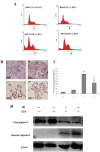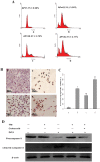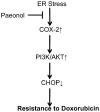Endoplasmic reticulum stress-induced resistance to doxorubicin is reversed by paeonol treatment in human hepatocellular carcinoma cells
- PMID: 23658755
- PMCID: PMC3643935
- DOI: 10.1371/journal.pone.0062627
Endoplasmic reticulum stress-induced resistance to doxorubicin is reversed by paeonol treatment in human hepatocellular carcinoma cells
Abstract
Background: Endoplasmic reticulum stress (ER stress) is generally activated in solid tumors and results in tumor cell anti-apoptosis and drug resistance. Paeonol (Pae, 2-hydroxy-4-methoxyacetophenone), is a natural product extracted from the root of Paeonia Suffruticosa Andrew. Although Pae displays anti-neoplastic activity and increases the efficacy of chemotherapeutic drugs in various cell lines and in animal models, studies related to the effect of Pae on ER stress-induced resistance to chemotherapeutic agents in hepatocellular carcinoma (HCC) are poorly understood.
Methodology/principal findings: In this study, we investigated the effect of the endoplasmic reticulum (ER) stress response during resistance of human hepatocellular carcinoma cells to doxorubicin. Treatment with the ER stress-inducer tunicamycin (TM) before the addition of doxorubicin reduced the rate of apoptosis induced by doxorubicin. Interestingly, co-pretreatment with tunicamycin and Pae significantly increased apoptosis induced by doxorubicin. Furthermore, induction of ER stress resulted in increasing expression of COX-2 concomitant with inactivation of Akt and up-regulation of the pro-apoptotic transcription factor CHOP (GADD153) in HepG2 cells. These cellular changes in gene expression and Akt activation may be an important resistance mechanism against doxorubicin in hepatocellular carcinoma cells undergoing ER stress. However, co-pretreatment with tunicamycin and Pae decreased the expression of COX-2 and levels of activation of Akt as well as increasing the levels of CHOP in HCC cells.
Conclusions/significance: Our results demonstrate that Pae reverses ER stress-induced resistance to doxorubicin in human hepatocellular carcinoma cells by targeting COX-2 mediated inactivation of PI3K/AKT/CHOP.
Conflict of interest statement
Figures










Similar articles
-
Bufalin Reverses Resistance to Sorafenib by Inhibiting Akt Activation in Hepatocellular Carcinoma: The Role of Endoplasmic Reticulum Stress.PLoS One. 2015 Sep 18;10(9):e0138485. doi: 10.1371/journal.pone.0138485. eCollection 2015. PLoS One. 2015. PMID: 26381511 Free PMC article.
-
Melatonin reverses tunicamycin-induced endoplasmic reticulum stress in human hepatocellular carcinoma cells and improves cytotoxic response to doxorubicin by increasing CHOP and decreasing survivin.J Pineal Res. 2013 Sep;55(2):184-94. doi: 10.1111/jpi.12061. Epub 2013 May 25. J Pineal Res. 2013. PMID: 23711089
-
Borax affects cellular viability by inducing ER stress in hepatocellular carcinoma cells by targeting SLC12A5.J Cell Mol Med. 2024 May;28(10):e18380. doi: 10.1111/jcmm.18380. J Cell Mol Med. 2024. PMID: 38780503 Free PMC article.
-
Endoplasmic reticulum stress: Multiple regulatory roles in hepatocellular carcinoma.Biomed Pharmacother. 2021 Oct;142:112005. doi: 10.1016/j.biopha.2021.112005. Epub 2021 Aug 20. Biomed Pharmacother. 2021. PMID: 34426262 Review.
-
Targeting ER stress in the hepatic tumor microenvironment.FEBS J. 2022 Nov;289(22):7163-7176. doi: 10.1111/febs.16145. Epub 2021 Aug 20. FEBS J. 2022. PMID: 34331743 Review.
Cited by
-
Targeting the hallmarks of cancer with therapy-induced endoplasmic reticulum (ER) stress.Mol Cell Oncol. 2014 Dec 1;2(1):e975089. doi: 10.4161/23723556.2014.975089. eCollection 2015 Jan-Mar. Mol Cell Oncol. 2014. PMID: 27308392 Free PMC article. Review.
-
The Role of the ER-Induced UPR Pathway and the Efficacy of Its Inhibitors and Inducers in the Inhibition of Tumor Progression.Oxid Med Cell Longev. 2019 Feb 3;2019:5729710. doi: 10.1155/2019/5729710. eCollection 2019. Oxid Med Cell Longev. 2019. PMID: 30863482 Free PMC article. Review.
-
Paeonol Attenuates Methotrexate-Induced Cardiac Toxicity in Rats by Inhibiting Oxidative Stress and Suppressing TLR4-Induced NF-κB Inflammatory Pathway.Mediators Inflamm. 2020 Feb 10;2020:8641026. doi: 10.1155/2020/8641026. eCollection 2020. Mediators Inflamm. 2020. PMID: 32104151 Free PMC article.
-
Bufalin Reverses Resistance to Sorafenib by Inhibiting Akt Activation in Hepatocellular Carcinoma: The Role of Endoplasmic Reticulum Stress.PLoS One. 2015 Sep 18;10(9):e0138485. doi: 10.1371/journal.pone.0138485. eCollection 2015. PLoS One. 2015. PMID: 26381511 Free PMC article.
-
Chronic treatment with paeonol improves endothelial function in mice through inhibition of endoplasmic reticulum stress-mediated oxidative stress.PLoS One. 2017 May 31;12(5):e0178365. doi: 10.1371/journal.pone.0178365. eCollection 2017. PLoS One. 2017. PMID: 28562691 Free PMC article.
References
-
- Lencioni R, Chen XP, Dagher L, Venook AP (2010) Treatment of intermediate/advanced hepatocellular carcinoma in the clinic: how can outcomes be improved? Oncologist 15 Suppl 442–52. - PubMed
-
- Mendizabal M, Reddy KR (2009) Current management of hepatocellular carcinoma.Med Clin North Am 93:885–900, viii. - PubMed
-
- Kapoor A, Sanyal AJ (2009) Endoplasmic reticulum stress and the unfolded protein response.Clin Liver Dis. 13: 581–590. - PubMed
-
- Rasheva VI, Domingos PM (2009) Cellular responses to endoplasmic reticulum stress and apoptosis. Apoptosis 14: 996–1007. - PubMed
Publication types
MeSH terms
Substances
LinkOut - more resources
Full Text Sources
Other Literature Sources
Research Materials

